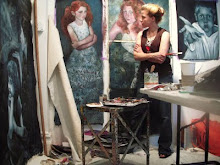
FORT WORTH, TX.- "Michelangelo’s painting of The Torment of Saint Anthony, described by his earliest biographers, has been acquired by the Kimbell Art Museum of Fort Worth, Texas. Its purchase was announced today by the Kimbell’s newly appointed director, Dr. Eric McCauley Lee. Executed in oil and tempera on a wooden panel, this work is the first painting by Michelangelo Buonarroti (1475–1564) to enter an American collection, and one of only four known easel paintings generally believed to come from his hand. The others are the Doni Tondo in Florence’s Uffizi Gallery and two unfinished paintings in London’s National Gallery, The Manchester Madonna and The Entombment."
signups@artknowledgenews.com
For interesting commentary and reflection on Michelangelo's work, visit Gregg Chadwick's blog at http://greggchadwick.blogspot.com/
Aside from the inventiveness of Michelangelo's composition, his skill and style, I of course think more about his psychological and spiritual state while in the process of creating and the influence and inspiration derived from religious institutions and philosophies, especially at that time.And for those of you who might think to compare this egg tempera painting to Michelangelo's Sistine Chapel (be still my heart as it is among my favorites:), keep in mind that he was born March 6, 1475 and this work may have possibly been painted in 1487 so that made him a mere 12 year old boy when he created this work! His talent and passion make me cry.
The agony and the ecstasy for certain! More on this later....I always forget that I have a "real" job and a "real" schedule so my art and artistic interests have been gently set aside and that feels like TORMENT:)













Thanks for the link to my piece on Michelangelo's "Torment of St. Anthony." An amazing glimpse into Michelangelo's "psychological and spiritual" process of becoming.
ReplyDeleteI appreciated the opportunity to view your thoughts on this painting and your own work as well.
Gregg, thank you. I checked out your blog as well and particularly liked the recent Geisha series. You work is atmospheric and ethereal. The monumental scale of the Geisha's portrait was a wonderful spurprise. She commands your attention:)Your palette is "delicate." Beautiful work and very mindful and meaningful commentary on your other blog.
ReplyDeleteHere is the link to view Gregg's recent work: http://greggchadwick2.blogspot.com/
ReplyDeleteThanks Jude!
ReplyDeleteI have just seen this painting at the Met, in NY. It is very impressive to see the bright colors in such an old painting. The demons are quite unusual with their fish scales and big eyes. It is said Michelangelo studied fish at the market in order to reproduce the demons in this painting. It is a small painting, only a bit larger than the cover of a regular sized dictionary. The original sketch from a German artist was hung beside the painting for comparison. It was forbidden to photograph the painting.
ReplyDeletethe original print was done by Martin Schongauer i think . I just discovered this and am wondering what it means.did he just color a print or what .theres no explanation.
ReplyDeletehttp://www.metmuseum.org/toah/hd/engr/ho_20.5.2.htm
I appreciate that information.After reading the excerpt composed by the Met,I am assuming that Michelangelo's composition was created,full color, after referencing Schongauer's print to which he may have had access.I wish I were more certain of the historical context.William Crowe of the Metropolitan Museum of Art is an amazing art historian. I will try to forward the question to him.Regards, Jude:)
ReplyDelete